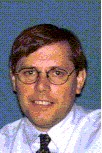When considering the IC technology roadmaps, one can observe that the IC complexity grows faster than the integration capabilities of the new technologies. An almost inevitable result of this is an increase in chip area and an increase in chip pin count, following the so-called Rent's rule. Within a few years, this will result in IC's with peripheral wire bond pads at a pitch of only 40 mm. Even using flip chip interconnects, distributed across the chip surface, very tight pad pitches will result. A 100 pin count die will have a full area array flip chip pitch of about 100 mm, a 900 pin count die will still require a full array of 300 mm pitch. This goes beyond the traditional laminate and ceramic technologies, which seem to be limited to minimum pitches of 100 mm.
Thin film multilayer technology, based on aluminium and copper interconnect lines, combined with photosensitive dielectric layers offer a solution to these problems. Line widths and spacings in the order of 10 mm can be achieved cost effectively using conventional mask processing on 200 mm diameter wafers or even large area substrates. If possible, the overall module size should however be kept below 3x3cm for yield reasons.
Some will argue that systems will be integrated fully on a single die, System-on-a-Chip COC, thus requiring only limited interconnects. Technological limitations, system diversity and economic reality point towards a different direction, the so-called System-In-a-Package SIP approach. As integration of functions becomes more successful, electronic (sub)systems will become smaller and more attractive to build as a single module. The interconnecting substrate will combine the role of high density IC interconnect as well as the interconnection of the module and the rest of the system. For this latter task, the module will "translate" the very high density interconnects at die level to the much coarser pitch of the printed circuit boards. This is similar to the "interposer" substrate in a ball grid array (BGA) package.
An ideal thin film technology should therefore be realised on a laminate substrate base. An example of such an MCM-SL/D technology will be presented.
Thin film technology also enables the high density integration of high quality passive circuit elements, such as resistors, capacitors, inductors and various types of transmission lines. This is particularly of interest for high frequency devices that require many of these elements. IMEC's approach to heterogeneous microwave integration will be discussed and examples of realised circuits will be shown.
Given the small contact pitch of die and the increasing operating frequencies, flip chip assembly of die will become more important. The fine pitch flip chip bumping technologies use thin film technology for the realisation of "redistribution"-layers and for the electroplating of the solder bumps.
IMEC
Kapeldreef 75
B-3001 Leuven
Belgium
Tel : +32 (0)16 281 261
Fax : +32(0)16 281 501
beyne@imec.be

Eric Beyne is secretary of the IMAPS-Benelux committee and member of the IMAPS-Europe technical program committee. IMAPS is the international microelectronics and packaging society.